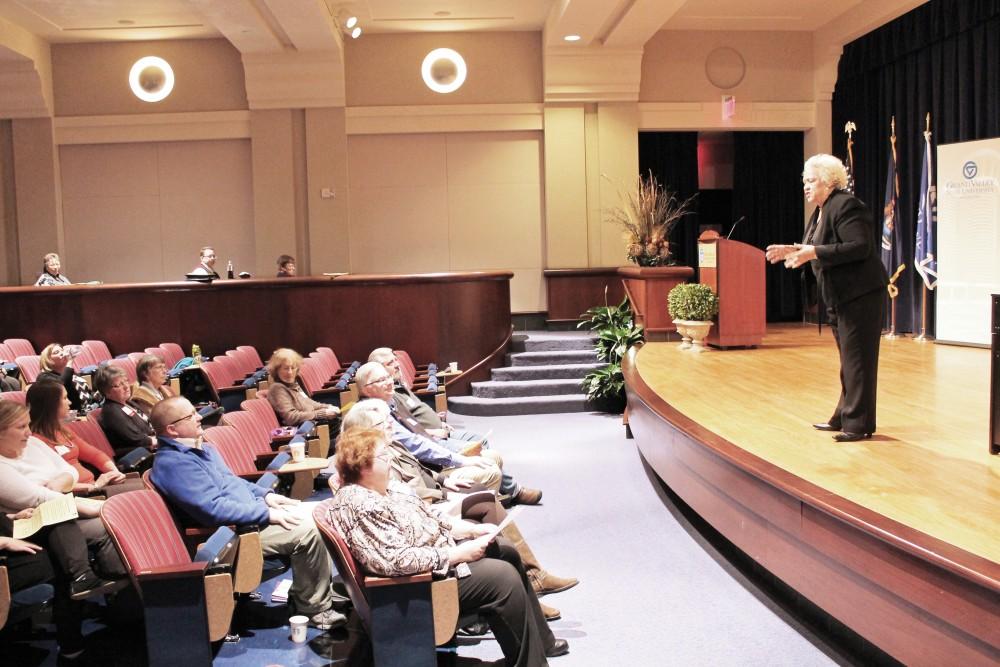Aging conference addresses stereotypes

GVL/Sara Carte Nellie Blue, Session: So You Think You Can’t Sing Outside the Shower
Feb 16, 2015
The 10th Annual Art & Science of Aging Conference is in the books.
On Feb. 13, 213 people were in attendance at the Grand Valley State University Loosemore Auditorium to hear New York Times bestselling author Ashton Applewhite advance awareness on age discrimination in America and what to do about it.
“We live in a society that systematically discriminates against older people and makes getting older much harder than it should be,” Applewhite said. “We need to work against that discrimination.”
Ageism, or discrimination based on age, especially prejudice against the elderly, is a subject near and dear to the heart of Applewhite, who was the first woman to have four books on the New York Times bestseller list at the same time.
“One of the signs of how entrenched ageism is is that advertisers are still advertising to the youth demographic even though the senior demographic has more assets and more disposable income by far than younger people,” Applewhite said.
Many people look down upon the elderly for a perceived lack of productivity in society. However, many of the services that older people are providing, such as babysitting, are not factored into common statistic, Applewhite said.
“That has economic value that is never factored into the conventional equations,” Applewhite said. “We absolutely have to broaden our notion of productivity.”
This over-generalization of ageism was one of the main elements addressed. For Applewhite, knowing is half the battle.
“So few people know how to define ageism,” Applewhite said. “And they are completely unaware of the way the culture in which we grow older can make the aging experience better or worse.”
Priscilla Kimboko, the founder of the Annual Art & Science of Aging Conference, tries to come up with a different theme each year. This year’s theme was “Life Balance: Keep Moving Forward in the Third Age.”
“That third stage is really the opportunity to do things you always wanted to do and you’re still healthy,” said Kimboko, GVSU professor of gerontology and health care management.
Kimboko founded the conference in hopes of facilitating discussion on how to make aging a more positive experience.
“(There are) so many stereotypes, negative attitudes, and fears,” Kimboko said. “We wanted to bring evidence-based research and practice to the attention of both professionals who work with older adults and to older adults themselves.”
Kimboko pointed out that balance needs to be achieved physically, spiritually and mentally. Exercise programs, faith of any kind and keeping your brain active all help to achieve that balance and can even help to stave off dementia and Alzheimer’s, Kimboko said.
Volunteering was one solution offered as a way for seniors to bust stereotypes.
“By getting out and doing those things, you are not only likely keeping yourself healthy by being active,” Applewhite said. “You are meeting people of all ages; you are meeting people who are into the same things you’re interested in.
“Just by getting out there, you are disrupting the stereotype of older people who do not do anything, who are not interested in things or whose lives are somehow boring and dull. As we get older and reach these ages that we are conditioned to dread, we get here and it’s actually pretty terrific.”
Applewhite discouraged the audience from accepting the idea of something being age-appropriate.
“There is no such thing as acting your age because ‘act your age’ implies there is a certain way people of a given age act, and that is not the case,” Applewhite said.
She pointed out that goes for clothes, activities, even going out to a club.
“We all should do the things we actually want to do,” Applewhite said. “If you really feel like doing it, I really recommend giving it a shot because it’s that kind of stuff that shatters people’s preconceptions.
“There’s no such thing as age-appropriate. You should wear miniskirts if you feel like wearing miniskirts, and if you don’t and it feels uncomfortable, don’t do it.”
Additionally, Applewhite stressed the idea that style belongs not to the younger generation, but anyone who claims it.
“Style is not the province of the young,” Applewhite said. “It’s the province of whoever feels like being stylish.
“Confidence is probably 80 percent of style. It’s not what you wear; it’s how you wear it.”
Throughout the session, Applewhite warned against narrow-mindedness when it comes to aging.
“If we can free ourselves up from this idea of age as this one-way decline and embrace it in all its complexity, we’re better off.”
The biggest way to impact culture and sway people from ageism is to call them on it in everyday conversation, Applewhite said.
“Say something thoughtful that helps the person think about what they just said,” Applewhite said. “If someone says, ‘You look great for your age,’ what I say is, ‘You look good for your age, too.’”
Responding to backhanded compliments in this way makes the person think about what they said without coming off as a jerk, Applewhite said.





















